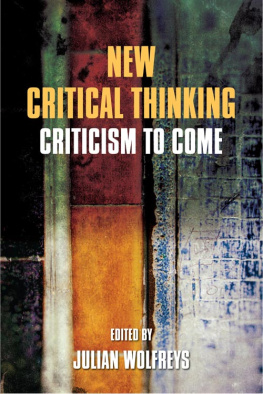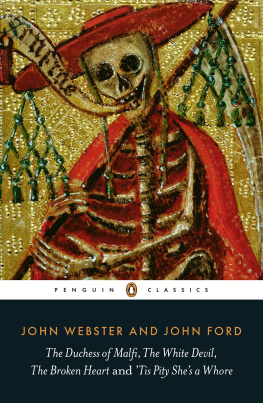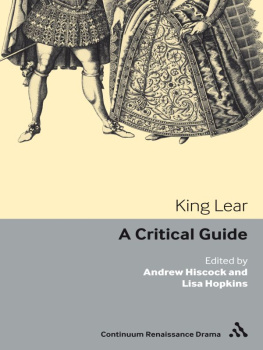The Duchess of Malfi
Continuum Renaissance Drama
Series Editors: Andrew Hiscock, University of Wales Bangor, UK, and Lisa Hopkins, Sheffield Hallam University, UK
Continuum Renaissance Drama offers practical and accessible introductions to the critical and performative contexts of key Elizabethan and Jacobean plays. Each guide introduces the texts critical and performance history but also provides students with an invaluable insight into the landscape of current scholarly research through a keynote essay on the state of the art and newly commissioned essays of fresh research from different critical perspectives.
A Midsummer Nights Dream Edited by Regina Buccola
Doctor Faustus Edited by Sarah Munson Deats
King Lear Edited by Andrew Hiscock and Lisa Hopkins
1 Henry IV Edited by Stephen Longstaffe
Tis Pity Shes a Whore Edited by Lisa Hopkins
Women Beware Women Edited by Andrew Hiscock
Volpone Edited by Matthew Steggle
Continuum International Publishing Group
The Tower Building | 80 Maiden Lane |
11 York Road | Suite 704 |
London SE1 7NX | New York, NY 10038 |
www.continuumbooks.com
Christina Luckyj and contributors 2011
All rights reserved. No part of this publication may be reproduced or transmitted in any form or by any means, electronic or mechanical, including photocopying, recording, or any information storage or retrieval system, without prior permission in writing from the publishers.
British Library Cataloguing-in-Publication Data
A catalogue record for this book is available from the British Library.
ISBN: 9781441117687
Library of Congress Cataloguing-in-Publication Data
A catalog record for this book is available from the Library of Congress.
Acknowledgements
I am grateful to Lisa Hopkins and Andrew Hiscock, general editors of this series, for giving me the opportunity to edit this volume on a play I wrote about many years ago a play that continues to haunt me as much as the Duchess does Bosola. I also thank the staff at Continuum for their patience with and understanding of my obligations as department Chair, which invariably led to delays in the publication schedule. Most of all, I want to express my gratitude to all the contributors to this volume. Scattered across the globe, busy with their own commitments, they nonetheless responded promptly and graciously to my requests and suggestions. I can only conclude that they too are lovers of this extraordinary, enigmatic and endlessly fascinating play. In particular, Leah Marcus generously provided us with the proofs of her Arden edition of The Duchess of Malfi, published by the Arden Shakespeare, an imprint of A&C Black Publishers Ltd. We all benefited from her work on the text and from her Introduction, which overlaps slightly with her contribution to this volume.
As always, my deepest thanks to Keith, Julia and Stefan Lawson: All discord without this circumference / Is only to be pitied and not feared.
Series Introduction
The drama of Shakespeare and his contemporaries has remained at the very heart of English curricula internationally and the pedagogic needs surrounding this body of literature have grown increasingly complex as more sophisticated resources become available to scholars, tutors and students. This series aims to offer a clear picture of the critical and performative contexts of a range of chosen texts. In addition, each volume furnishes readers with invaluable insights into the landscape of current scholarly research as well as including new pieces of research by leading critics.
This series is designed to respond to the clearly identified needs of scholars, tutors and students for volumes which will bridge the gap between accounts of previous critical developments and performance history and an acquaintance with new research initiatives related to the chosen plays. Thus, our ambition is to offer innovative and challenging Guides which will provide practical, accessible and thought-provoking analyses of Renaissance drama. Each volume is organized according to a progressive reading strategy involving introductory discussion, critical review and cutting-edge scholarly debate. It has been an enormous pleasure to work with so many dedicated scholars of Renaissance drama and we are sure that this series will encourage you to read 400-year-old playtexts with fresh eyes.
Andrew Hiscock and Lisa Hopkins
Timeline
1478: Birth of Giovanna dAragona.
1498: Giovanna rules as regent in the Duchy of Amalfi after her husbands death.
1510: Giovannas clandestine marriage to Antonio Bologna revealed.
1511: Giovanna and her two younger children imprisoned and presumably killed.
1513: Antonio Bologna murdered by Daniele da Bozzolo.
15541573: The four volumes of Matteo Bandellos Novelle published (Il signor Antonio Bologna sposa la duchesse dAmalfi being the twenty-sixth in Part One).
1565: Belleforest, Histoires tragiques published (including The Unfortunate marriage of Seigneur Antonio Bologna with the Duchess of Malfi, and the piteous death of both).
1567: William Painter, Palace of Pleasure published (The Infortunate Mariage of a Gentleman, called Antonio Bologna, with the Duchesse of Malfi, and the pitifull death of them bothe, being the twenty-third novel).
1578/79: John Webster born to John Webster Sr. a wealthy London coachmaker.
1598: John Webster (possibly the dramatist) admitted to the Middle Temple, Inns of Court.
1602: Payment to Webster (with a team of collaborators including Dekker, Heywood, Chettle, Munday, Middleton and Drayton) recorded in Henslowes Diary for plays now lost.
1604: Webster provides the Induction for the third edition of The Malcontent by John Marston, performed by the Kings Men at the Globe.
1604: Webster collaborates with Thomas Dekker on Westward Ho, a popular citizen comedy for the Children of Pauls.
1605: Webster collaborates again with Thomas Dekker on Northward Ho.
1606: Webster marries Sara Peniall, who at age 17 is pregnant with their first child.
1612: Websters first independent play, The White Devil, performed by Queen Annes Men, not well received at the Red Bull.
1612:The White Devil published by Thomas Archer containing Websters angry and defensive Address to the Reader in which he lambasts audiences as ignorant asses.
1612: Publication of A Monumentall Column, Websters elegiac tribute to Prince Henry, eldest son of King James and popular Protestant champion, who dies at the age of 18.
1613/14: Websters second independent play The Duchess of Malfi performed by the Kings Men at the Globe and Blackfriars Theatres.
1615: Webster contributes thirty-two Characters (including An Excellent Actor and A Virtuous Widow) to the sixth edition of Sir Thomas Overburys The Wife, a bestseller memorializing Overburys scandalous death by poison at the hands of the Kings favourite Robert Carr and his new wife Frances Howard.













